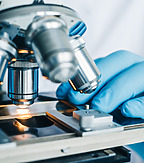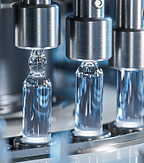Artikel | 14 maj 2020
Registering trademarks for medical devices

Technological developments, the increasing number of medical devices available and the continued strong demand for medical services are significant factors behind the expanding medical device industry. To keep up with developments on the market, the European Union has implemented two new regulations: the Medical Device Regulation (MDR) and the In Vitro Device Regulation (IVDR), which we have previously reported on. The implementation of the MDR has recently been postponed until 26 May 2021, while the IVDR will be implemented on 26 May 2022.
It is important that companies operating in the medical device industry distinguish their products for users, such as healthcare providers, medical professionals, patients and other end users. A strong trademark is an efficient tool for distinguishing one device from another.
This article highlights some general aspects of registering a trademark, selecting a trademark in compliance with the MDR and the appropriate timing of filing for trademark protection before a medical device is put on the market.
Registering a trademark in general
Trademark protection for medical devices is important for device recognition and marketing purposes, creating trust among users and for other commercial reasons that a well-known trademark implies. However, it is important to perform a trademark IP analysis prior to filing for trademark registration.
For example, you should avoid choosing trademarks that may be deemed descriptive or confusingly similar to any existing trademarks, as this may hinder registration. Furthermore, an evaluation should be made as to which category of goods and services the trademark should be applied for. For instance, depending on the nature of the medical device, the trademark may possibly be registered in the Nice Classification Class 9 for software for medical purposes and/or in Class 10 for surgical and medical instruments and apparatus.
Registering a trademark in compliance with the MDR
Another important aspect in connection with an IP analysis for medical devices is to comply with the legal requirements for trademarks under the MDR. Such requirements include a number of different aspects, including labelling, instructions for use, making available, putting into service and advertising of a medical device. Moreover, it is prohibited to use any trademark that may mislead users about the intended purpose of the device, its safety or its performance. Neither is it permitted to refer to any characteristics, functions or properties that the device does not possess. In addition, one may not create false impressions regarding treatment or diagnosis, functions or properties that the device does not have. Finally, it is prohibited to suggest any specific uses of the device other than those relating to its intended purpose.
Registering a trademark during a clinical evaluation
It is important that companies operating in the medical device sector identify the right time to seek trademark protection. If trademark protection is filed for too late, you run the risk of another operator registering the same or a similar trademark. Although it is beneficial to register trademarks well in advance, there are also risks associated with registering a trademark prior to placing the device on the market. Under the applicable legislation, a trademark must be put to genuine use within a period of five consecutive years from the registration of a trademark, otherwise registration may be revoked.
As mentioned above, one of the requirements for placing a medical device on the market is ensuring compliance with the MDR and confirming that the device is safe for its intended use through clinical evaluations. Evidence of compliance must be based on clinical data, which can be obtained through reported studies or clinical trials. As clinical evaluations in general, and clinical trials in particular, are often time-consuming, the question arises as to when an application for trademark protection should be filed in relation to the conduct of such studies.
The Court of Justice of the European Union (CJEU) has fairly recently addressed the issue of early registration of a trademark for a pharmaceutical product (i.e. not a medical device) that, due to clinical trials, had not yet been put on the market, despite five years having lapsed since registration of the trademark.
In the case, the CJEU had to rule whether a trademark (i) had been put to “genuine use” during a clinical trial and (ii) whether there was a “proper reason for non-use” of the trademark that was sufficient for the trademark to not be revoked.
On the question of “genuine use”, the CJEU concluded that a clinical trial in itself would not demonstrate genuine use because the use of the trademark during the clinical trial was only for internal use. The CJEU considered whether use in clinical trials could be regarded as a preparatory activity with a view to commercialisation. However, this was rejected by the court as preparatory activities may be deemed to be genuine use only if actual commercialisation is imminent and imply an external effect for future consumers. In the case at hand, the company was unable to prove imminent commercialisation, as it failed to provide evidence that the clinical trials were about to be concluded.
As regards the question of “proper reason for non-use”, the company argued that there is a prohibition on advertising pharmaceutical products prior to securing marketing authorisation. However, it was the opinion of the CJEU that only obstacles that make it impossible or unreasonable to use the trademark may fall under the scope of proper reason for non-use. The court took into consideration that the company was partly responsible for the unnecessarily long time taken for the clinical trials and, consequently, the timing of product commercialisation. The CJEU found in this specific case that there was not a proper reason for non-use.
As mentioned, there are several risks associated with early trademark registration. Consequently, the decision emphasizes the importance of filing for trademark registration at a point of time that is not too far in advance of when the pharmaceutical product will be put on the market.
The requirements in respect of clinical trials for pharmaceutical products are not identical to the corresponding requirements for medical devices. Nevertheless, the arguments put forward by the CJEU regarding the criteria for genuine use and proper reason for non-use, as summarised above, may also have some relevance when conducting an IP analysis for medical devices.
General conclusions
To sum up, the registration and use of a trademark for a medical device require careful and strategic planning. Not only do medical device operators have to go through the standard trademark registration process, but they also have to comply with any specific requirements set out in the MDR.
We would be happy to provide further guidance if you should you need any assistance applying for, or otherwise securing, your trademarks.


